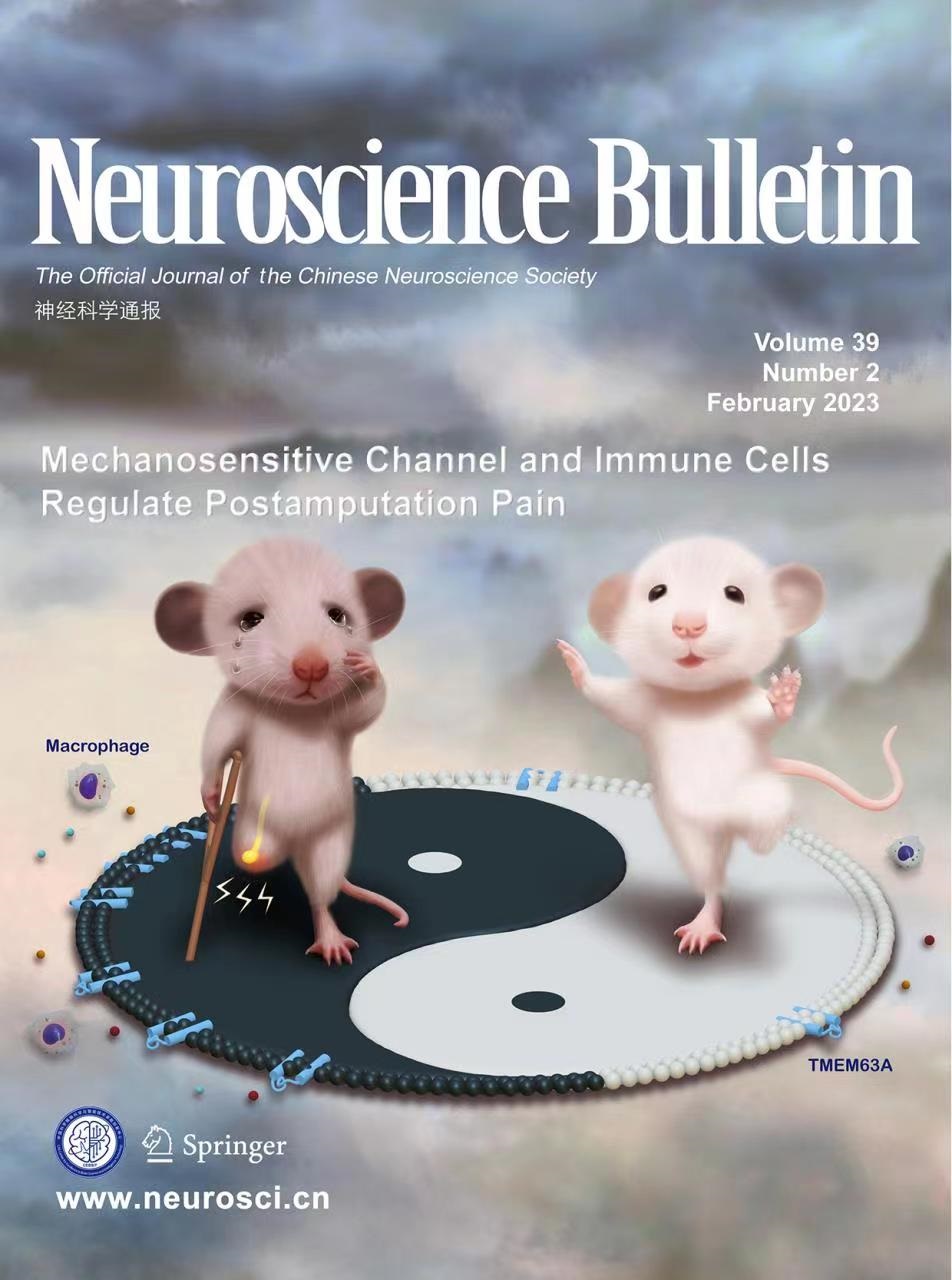Mechanosensitive Ion Channel TMEM63A Gangs Up with Local Macrophages to Modulate Chronic Post-amputation Pain
Shaofeng Pu1 • Yiyang Wu1 • Fang Tong2 • Wan‑Jie Du2 • Shuai Liu2 • Huan Yang2 • Chen Zhang2 • Bin Zhou2 • Ziyue Chen2 • Xiaomeng Zhou2 • Qingjian Han2 • Dongping Du1
2023,39(2):177–193 [
Abstract] [
SpringerLink]
[PDF]
miR-34b-3p Inhibition of eIF4E Causes Post-stroke Depression in Adult Mice
Xiao Ke1,2 • Manfei Deng1,2 • Zhuoze Wu3 • Hongyan Yu1,2 • Dian Yu1,2 • Hao Li1,2 • Youming Lu2,4 • Kai Shu5 • Lei Pei1,2
2023,39(2):194–212 [
Abstract] [
SpringerLink]
[PDF]
Spatiotemporal Dynamics of the Molecular Expression Pattern
Leilei Gong1 • Yun Gu1 • Xiaoxiao Han1 • Chengcheng Luan1 • Chang Liu1 • Xinghui Wang1 • Yufeng Sun1 • Mengru Zheng1 • Mengya Fang1 • Shuhai Yang1 • Lai Xu1 • Hualin Sun1 • Bin Yu1 • Xiaosong Gu1 • Songlin Zhou1
2023,39(2):213–244 [
Abstract] [
SpringerLink]
[PDF]
Somatostatin-Positive Neurons in the Rostral Zona Incerta Modulate Innate Fear-Induced Defensive Response in Mice
Shan Lin1,2 · Meng‑Yue Zhu1,2 · Meng‑Yu Tang1,2 ·
Mi Wang1,2 · Xiao‑Dan Yu1,2 · Yi Zhu1,2 · Shi‑Ze Xie1,2 ·
Dan Yang1
· Jiadong Chen1,2 · Xiao‑Ming Li1,2,3
2023,39(2):245–260 [
Abstract] [
SpringerLink]
[PDF]
Elevated Levels of Naturally-Occurring Autoantibodies Against the Extracellular Domain of p75NTR Aggravate the Pathology of Alzheimer's Disease
Chen‑Yang He1,8 · Ding‑Yuan Tian1,5 · Si‑Han Chen1,6 · Wang‑Sheng Jin1,3 · Yuan Cheng1
· Jia‑Yan Xin1,7 ·
Wei‑Wei Li1,8 · Gui‑Hua Zeng1,3 · Cheng‑Rong Tan1,3 · Jie‑Ming Jian1
· Dong‑Yu Fan1,9 · Jun‑Rong Ren1
·
Yu‑Hui Liu1,3 · Yan‑Jiang Wang1,2,3,4 · Fan Zeng1,3
2023,39(2):261–272 [
Abstract] [
SpringerLink]
[PDF]
Extension of the Lifespan of a Mouse Model of Rett Syndrome by Intracerebroventricular Delivery of MECP2
Kan Yang1
· Cheng Cheng2
· Yiting Yuan1
·
Yuefang Zhang1
· Shifang Shan1
· Zilong Qiu1,3
2023,39(2):297–302 [
Abstract] [
SpringerLink]
[PDF]
MAGED4B Promotes Glioma Progression via Inactivation of the TNF-α-induced Apoptotic Pathway by Down-regulating TRIM27 Expression
Can Liu1,2 · Jun Liu2,3 · Juntang Shao2,3 · Cheng Huang4
· Xingliang
2023,39(2):273–291 [
Abstract] [
SpringerLink]
[PDF]
Connectivity Map of Subthalamic Corticotropin-releasing Hormone Neurons in the Mouse Brain
Yu‑Ting Tseng1
· Lisha Liang1,2 · Binghao Zhao1
·
Jialin Ye1,2 · Liping Wang1
2023,39(2):292–296 [
Abstract] [
SpringerLink]
[PDF]
Extension of the Lifespan of a Mouse Model of Rett Syndrome by Intracerebroventricular Delivery of MECP2
Kan Yang1
· Cheng Cheng2
· Yiting Yuan1
·
Yuefang Zhang1
· Shifang Shan1
· Zilong Qiu1,3
2023,39(2):297–302 [
Abstract] [
SpringerLink]
[PDF]
Mechanisms Underlying Brain Aging Under Normal and Pathological Conditions
Menglong Jin1,2 · Shi‑Qing Cai1
2023,39(2):303–314 [
Abstract] [
SpringerLink]
[PDF]
Neural Correlates of Spatial Navigation in Primate Hippocampus
Dun Mao1,2
2023,39(2):315–327 [
Abstract] [
SpringerLink]
[PDF]
Brain Systems Underlying Fundamental Motivations of Human Social Conformity
Xinling Chen1,2,3,4 · Jiaxi Liu1,2,3,4 · Yue‑Jia Luo5,6,7,8 ·
Chunliang Feng1,2,3,4
2023,39(2):328–342 [
Abstract] [
SpringerLink]
[PDF]
Potential Effects of the COVID-19 Pandemic on the Developing Brain
Xiang Yu1,2,3 · Xiu Xu4
2023,39(2):343–347 [
Abstract] [
SpringerLink]
[PDF]
Brain-Computer Interfaces in Disorders of Consciousness
Qiheng He1,4 • Jianghong He1 • Yi Yang1,2,3,4 • Jizong Zhao1,4
2023,39(2):348–352 [
Abstract] [
SpringerLink]
[PDF]
Stereopure AIMer: A Promising RNA Base-editing Tool for Monogenic Neurological Diseases
Jingyu Yu1
· Tianwen Li1
· Kezhu Chen1
·
Qisheng Tang1
· Jianhong Zhu1
2023,39(2):353–355 [
Abstract] [
SpringerLink]
[PDF]
PROK2–PROKR2 Signaling: New Contributor to Pleasant Touch
Feng‑Lin Chen1
· Hai‑Yan Yin1,2 · Yong Tang1,2,3
2023,39(2):356–358 [
Abstract] [
SpringerLink]
[PDF]
Infusion of Cerebrospinal Fluid from Young Mice Reverses Memory Loss in Aged Mice
Luodan Yang1 · Quanguang Zhang1
2023,39(2):359–361 [
Abstract] [
SpringerLink]
[PDF]
Charting Normative Brain Variability Across the Human Lifespan
Yongbin Wei1
· Han Zhang1
· Yong Liu1
2023,39(2):362–364 [
Abstract] [
SpringerLink]
[PDF]
